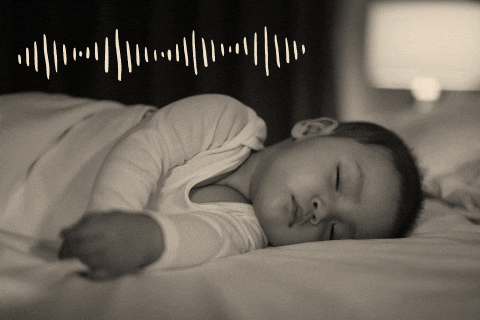But just how low risk is it? To find out, we conducted a review of the available literature on white noise machines for young children. The results, recently published in the journal Sleep Medicine, showed that all tested devices generated alarmingly loud sounds.
There is no uniform standard for noise exposure from consumer products like white noise machines. For occupational noise, however, the National Institute for Occupational Safety and Health (NIOSH) recommends limiting exposure to less than 85 decibels over eight hours and 82 decibels over 16 hours. That’s roughly equivalent to noise from a lawn mower over eight hours or standing near busy traffic for 16 hours.
A toddler might sleep for 10 to 12 hours a night, but infants may sleep up to 16 hours over the whole day. In our review, we found that across 24 white noise machines and six phone apps, all could produce sound that violated the NIOSH guideline for an eight-hour work shift. Some white noise machines can reach volumes of 91 decibels — around the same level as a Metrorail train roaring through a station at top speed.
Most parents probably aren’t setting the machines at the loudest setting. But this finding means that during a typical night’s sleep, a white noise machine at maximum volume exposes children to noise that can cause permanent hearing loss.
Changing the type of sound to music, static, rumble or tones does not make the sound safer, but lowering the volume does. In general, you should keep your white noise machine at the lowest volume that helps your child sleep. Our recommendation is to keep the volume at 60 decibels or less.
Can white noise machines damage hearing?
White noise exposure near its maximum volume is harmful in multiple ways. Loud, extended noise exposure causes mechanical stress to inner ear sensory hair cells, inflammatory damage to their supporting structures and damage to the nerve ending to the hair cells. This causes breakage of the tiny hairlike receptor proteins on their surface, cell death and loss of supporting cells.
Our research builds on this to show that white noise exposure in young children is even more of a concern due to its potential impact on physiological and social development. Animal models with noise exposure between 60 and 80 decibels have shown stunted vocal development and delayed development of neurons in the auditory processing centers of the brain.
Similarly, studies of children near high ambient noise like high traffic, train or plane noise have been linked to negative effects on sleep duration, sleep disturbances, cognitive development, behavioral issues, reading proficiency and even changes on brain imaging of regions related to language development.
What is a safe level for a white noise machine?
White noise within reasonable limits may help children — and parents — sleep without causing harm. We found studies showing that white noise applied at 60 decibels or less — about the volume of a quiet conversation — showed a decrease in nighttime arousals, increased sleep time and increase sleep efficiency (time spent asleep while in bed).
To check whether your white noise machine is at a safe volume, you can purchase a decibel meter online or download an app on your smartphone. NIOSH created a free app calibrated specifically for iPhones, called the NIOSH Sound Level Meter (SLM) app.
Place the white noise machine at the volume you usually use it and place your decibel meter where your child sleeps. The sound intensity should be well below 82 decibels.
Lt. Col. Isaac Erbele is the associate program director for otolaryngology-head and neck surgery at Brooke Army Medical Center in San Antonio. Capt. Russell De Jong is a resident surgeon in otolaryngology-head and neck surgery at Brooke Army Medical Center in San Antonio. The views expressed herein are those of the author(s) and do not reflect the official policy or position of Brooke Army Medical Center, Wilford Hall Ambulatory Surgical Center, the Defense Department or any agencies under the U.S. government.
#safe #play #white #noise #machine #night,
#safe #play #white #noise #machine #night
